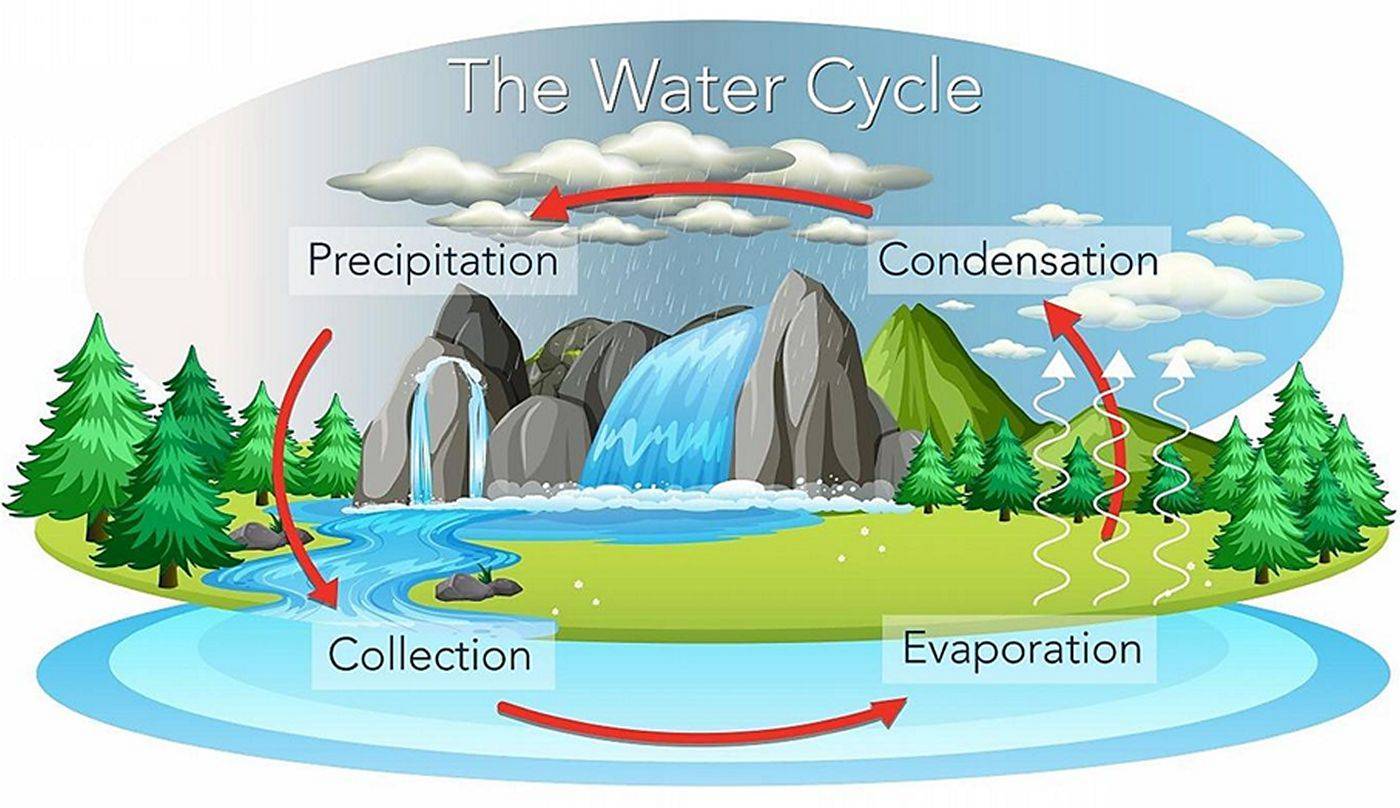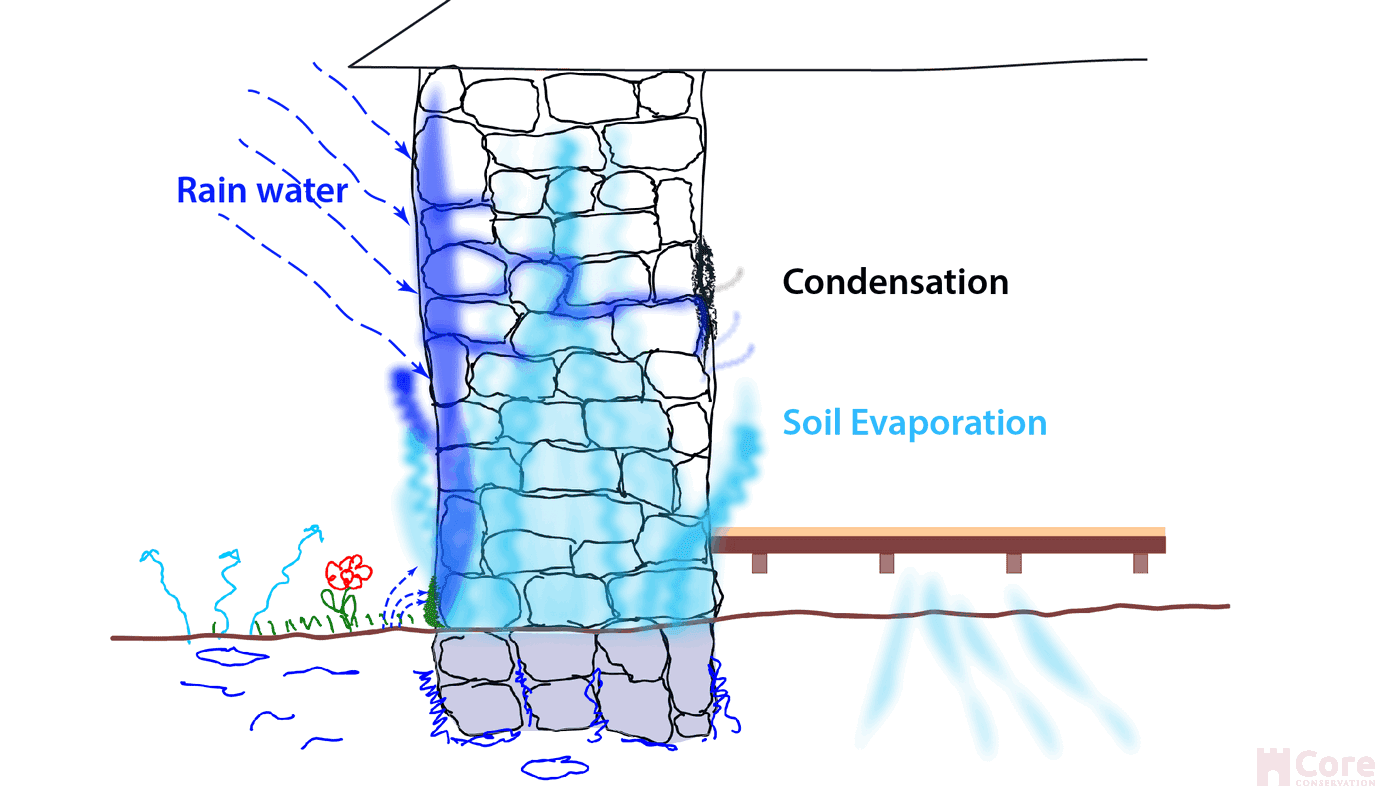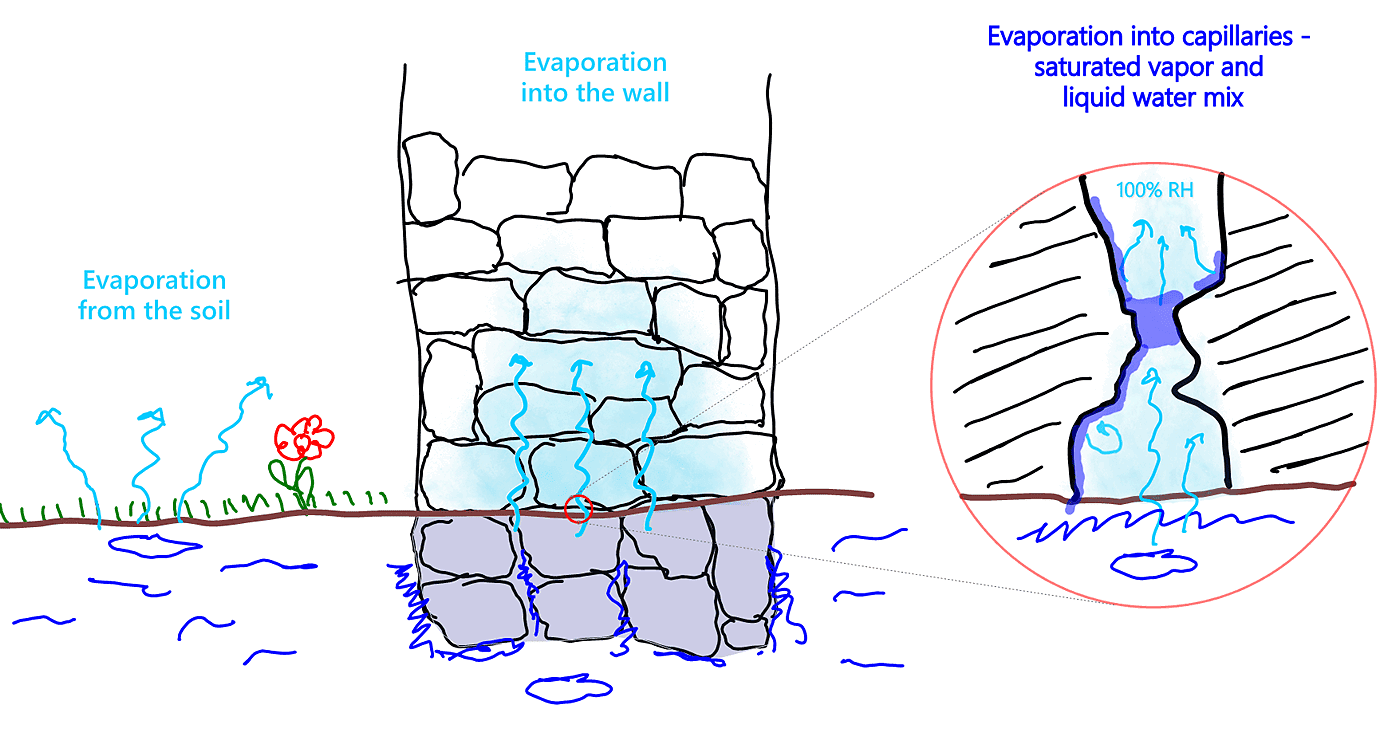The topic of moisture sources in old buildings can be easiest understood by inspecting and understanding the main Water Cycle in nature. The moisture content of old buildings, which are an integral part of the greater environment, are being driven by the natural Water Cycle.
The Water Cycle in Nature
The Water Cycle describes the large-scale movement of water in nature. The Water Cycle comprises of two main vertical flows:
- The falling flow: water in liquid form falls to the ground as rainwater (precipitation)
- The rising flow: water in vapour form rises as water vapours (evaporation)

The Water Cycle in nature
These two flows are equally important as they are in balance: in nature there is just as much ongoing evaporation as there is rainfall. Together, these opposite flows form the main Water Cycle in nature.
Old buildings are affected by both of these flows. They have different characteristics, they behave differently and they create different effects in old buildings.
Moisture Sources in Old Buildings
Here are the main moisture sources affecting old buildings:
1. Rainwater Ingress
This is one of the most obvious water flows caused by falling rainwater. Rainwater can damage old buildings in several ways. Depending on its point of entry we can talk about water ingress, wind-driven rain, roof leaks, chimney leaks etc, but all these problems have the same common source: rainwater ingress.
While rain can be very abundant, it is important to understand that it is an intermittent flow: periods of rain (wetting) being followed by shorter or longer periods of no-rain (drying). Rainwater is also a freshwater flow – clean distilled water wetting the building fabric – with little to no salt content.

Moisture sources in old buildings
2. Rising Damp
Rising damp is caused by the reverse arm of the falling liquid flow – vapours from the soil evaporating and rising upwards inside the wall fabric .
Despite its rather invisible nature, it is equal in flow intensity to falling rain, but with markedly different characteristics from rainwater. Unlike rainwater, which is an intermittent (on-off) abundant flow, the rising vapour flow is a less abundant but permanent (always on) flow, affecting old building structures 24/7 over long time periods (for decades or centuries), with no breaks.

Rising damp is caused by the always-on soil evaporation
Rising damp is caused by the evaporating soil moisture. The falling rainwater is collected in the soil, which then starts evaporating upwards inside the capillaries. The pressure generated by the ongoing evaporation makes water liquefy inside the wall pores, resulting in a liquid film then a partial or full capillary flow inside the capillaries.

The liquid water flow starts transporting diluted salts from the ground into the capillaries, resulting in active salt transportation from the soil into the wall fabric; the water flow depositing solid materials (salts) into the wall. Unlike rainwater ingress, which is “just” clean freshwater flow, rising damp is a “polluted” water flow containing salts, a combined flow of water and salts.
The table below summarizes the key differences between the falling and rising flows of the Water Cycle:
Falling Flow | Rising Flow | |
|---|---|---|
Frequency | Intermittent (on-off) | Permanent (always-on) |
Intensity | Abundant (liquid) | Less abundant (vapours) |
Salt content | None | Can be significant |
Problem caused | Rainwater ingress | Rising damp |
We are going to see later that the presence of salts alone, the main feature of rising damp, is an extremely important variable, making rising damp a significantly more complex phenomenon than rainwater ingress.
The mechanism of rising damp and its characteristics are covered in much more detail at the rising damp page.
3. Condensation
Moisture in old buildings undergoes a constant transformation between liquid and vapour phases.
Condensation denotes the phase change of water from vapour to liquid. The opposite of condensation is evaporation, when liquid water turns into vapours.
Condensation can occur for two reasons:
- Due to low temperatures: low temperatures facilitate the liquefication of water, resulting in condensation and black mould. Lack of thermal insulation, cold bridging etc. cause condensation due to low temperatures.
- Due to excess humidity: if enough moisture is present in the air water can liquefy even at warmer temperatures (e.g. in a steamy bathroom, in a tropical rain forest etc.). We often encounter this phenomenon in the core of the wall with rising damp present: vapours liquefies in the capillaries due high humidity and ongoing evaporation pressure.
Condensation can create dampness problems due vapours turning into liquid moisture.
The mechanism of condensation and its characteristics are covered in much more detail at the condensation page.
4. Hygroscopic Moisture
Hygroscopic moisture is caused by salts present in old masonry. Salts are solid materials normally not present in new masonry, but in diluted form they can be carried by water into the fabric of old buildings. Salts can originate and be deposited into the masonry from a variety of sources, including the soil via rising damp, sea spray or fog in coastal towns or the polluted air in larger cities.
Once in the building fabric, salts have the ability to attract and electro-chemically bond humidity from the surrounding environment (known as hygroscopic action), resulting in damp patches on the walls when ambient humidity is high (e.g. after rain, throughout the wet season etc.).
Strictly speaking, salts are a secondary source of moisture, not a primary one, as their action depends on the presence of other moisture, which they capture and accumulate.
The presence of salts in old masonry has very far-reaching consequences in building conservation as it affects not only the breathability of the wall fabric (salts acting as moisture barriers) but also renovation best practices.
More information on the mechanisms of how salts damage the masonry can be read at the "How salts damage old buildings" page.





